Today, your author will be yakking about the 1979 Collector’s Series. This car, and its Continental Mark V Collector’s Series companion model, marked the final versions of the lovely, large and in charge Lincoln Continentals of yore. These special editions celebrated the Great American Land Yacht, whose time was rapidly drawing to a close. Starting in 1980, both the Continental and the Mark would go on a crash diet, never again returning to such grand dimensions.
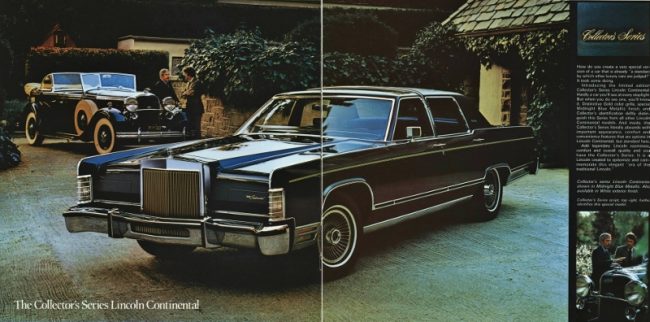
It was the end of an era, with the big, blowsy Chrysler New Yorker bowing out after 1978 and the muy grande Caddys in ’76 (although the big Eldorado and Toronado carried on through ’78 with their full dimensions, same as the New Yorker Brougham). Ford Motor Company held out the longest, perhaps due to Henry Ford II’s long-held disdain for little cars. Though he did have a customized Pinto at one point.
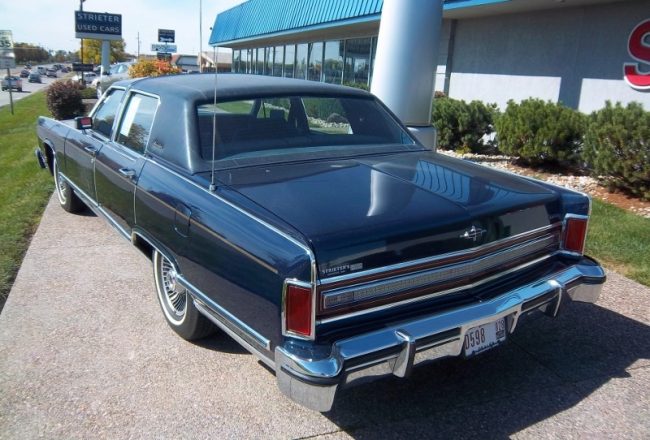
CAFE, AKA Corporate Average Fuel Economy, really bit the American manufacturers in their collective posteriors. Americans liked big cars back then. True, many fine folks went to imports and Vegas, Pintos and Gremlins after the ’73 gas scare, but once things settled down, true to form, those very same fine folks went out, traded in their mini-me cracker boxes, and bought their traditional Delta 88s, LTDs and Impalas once again. But CAFE’s arrival in 1978 changed the status quo, and the Big Three were going to have to either adapt, or pay through the nose in government fines.
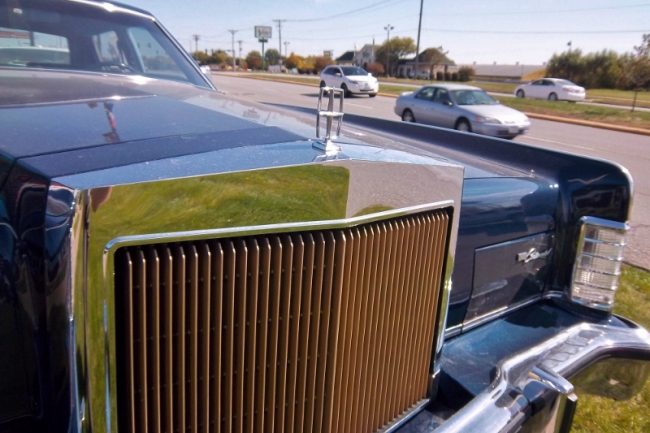
Thus, really big cars started to drop off one by one. GM was the early adopter with their right-sized 1977 B- and C-bodies. Continually strapped Chrysler “downsized” their Monaco by slapping the nameplate on the ex-Coronet B-body, and the C-body Royal Monaco and Gran Fury departed that same year. Ford introduced the “downsized” LTD II, but it was really just a Gran Torino in a Nehru jacket.
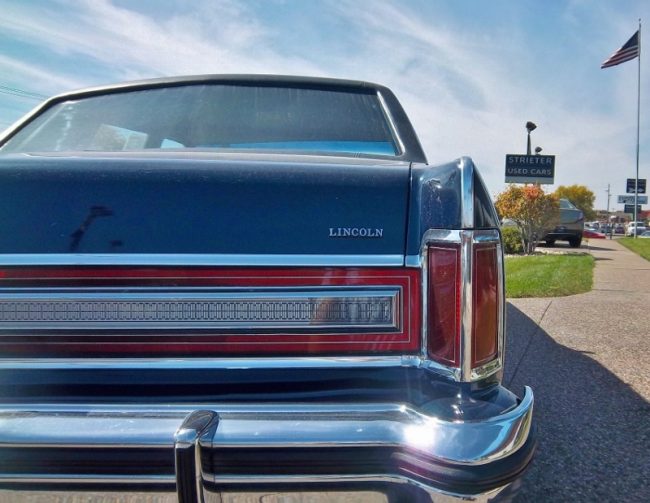
In 1978, Ford was the only company that still had a full line of big LTD, Marquis and Continental coupes and sedans–plus the Colony Park and Country Squire wagons. But the Panther took over for the 1979 model year, leaving Lincolns as the only full-figured option.

If you walked into a L-M showroom in the fall of 1978 and ordered just a plain white, no-option Continental Sedan, you still got quite the comfy, well-equipped vehicle. All that weight, the long wheelbase and sound deadening combined to make for a very plush ride, if a bit sea sickness-inducing at times. The only concession to CAFE was the departure of the big-block 460 CID V8–all Continentals had to make do with the 400 CID engine.
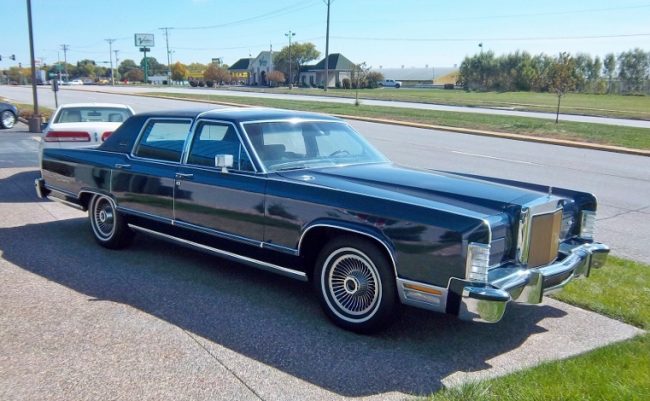
Yes, it was the end of a long line of big, cushy Continentals, but it wasn’t quite over yet. As long as the music’s still playing, might as well dance while we’re here, right? So to celebrate the last of the biggies, the Collector’s Series was introduced.
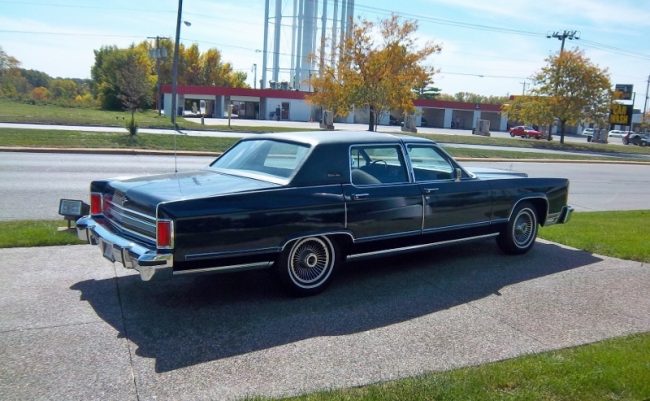
Available on both the Continental Sedan and Continental Mark V (sorry, Town Coupé fans, you were out of luck), the package included your choice of White or Midnight Blue paint (though a handful made it out the door with silver paint).
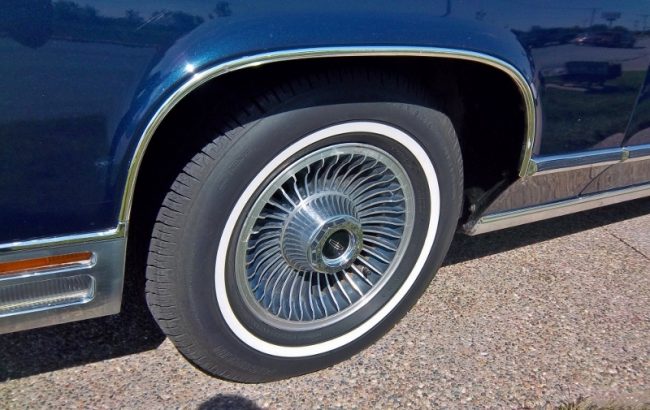
The turbine alloy wheels were accented with Midnight Blue paint, and Collector’s Series scripts graced the sail panels. A gold-accented grille, standard coach roof with opera lights, and the premium bodyside moldings rounded out the exterior changes.
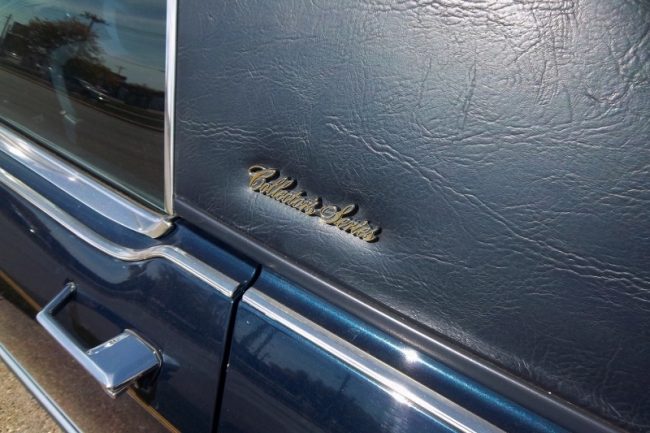
The trademark oval opera window was not available on either the Mark V or Continental CS. And these models were NOT Town Cars, despite the premium equipment and Town Car seats. The giveaway was the lack of Town Car script on the front fenders, and the “Lincoln Continental” badge on the instrument panel, instead of “Lincoln Town Car.”

Inside, extra-plush 36-ounce carpet was standard, as well as Kasman II luxury cloth for the seating–unless you preferred leather. A leather-bound owner’s manual, tool kit and umbrella were also included. Many features optional on the Continental and Town Car/Coupé were standard on the CS, such as illuminated entry, an integrated visor-mounted garage door opener, and the top-drawer Electronic AM/FM Stereo Search radio with built-in 8-track player.

Despite the hoopla of the “last big Continental,” the second gas crisis struck not long after the ’79s went on sale, and most Americans once again went on a small-car shopping spree–again, temporarily. As a result 1979 Continentals languished on L-M dealership lots, and it is likely that you could still get a brand new one well after the ’80 Panther Continentals started appearing.
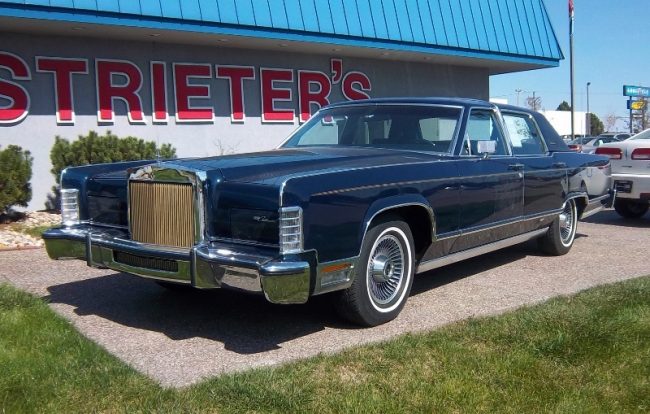
Like my Grandpa Bob’s 1987 Continental, I was heavily influenced by a 1979 Collector’s Series. Our neighbors across the alley, the Yokases, were middle-aged when I was a kid and Bill was very tolerant of me and my brother visiting. He worked in his garage all the time, and had woodworking equipment in there, among other cool stuff.
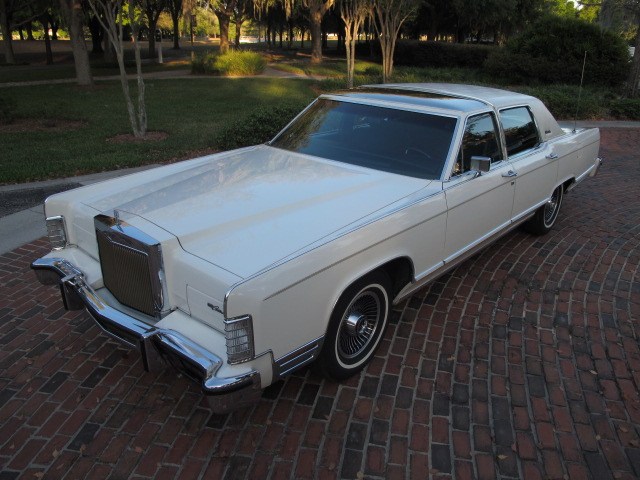 image courtesy of my buddy Dave Smith, AKA That Hartford Guy. That Hartford Guy’s photostream on flickr
image courtesy of my buddy Dave Smith, AKA That Hartford Guy. That Hartford Guy’s photostream on flickr
One of the other cool things in there was a pristine white 1979 Continental CS, in white with the navy cloth interior–I believe it also had the factory CB radio (though not the fixed glass moonroof on the example above). It had belonged to Bill’s brother, and he inherited it when he passed away.
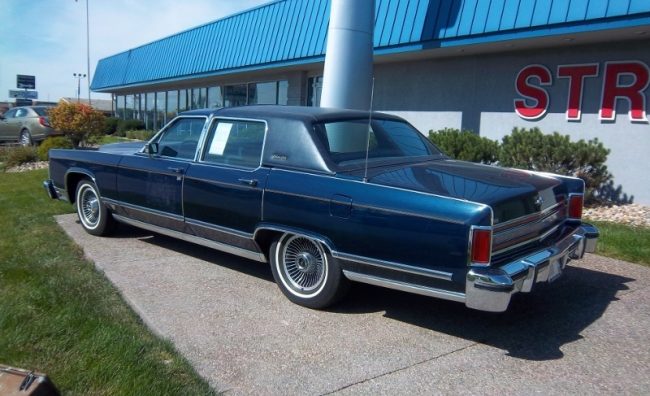
The Continental was strictly for special occasions, and always resided in the unattached garage. Indeed, ONLY the Continental was in the garage, as the other half of the two-bay structure was given over to Bill’s tools, wood lathe, etc. His wife’s car lived in the single-stall garage that was built into the house.

His daily driver was a black 1982 non-woody Cougar wagon, with dark red interior. Before that, he had a gigantic dark green 1972 Pontiac Safari. At the same time his wife had a fastback Pontiac J2000 (later traded for a 2nd-gen Voyager SE), his daughter, who was in her early 20s back then, had a maroon 25th Anniversary Cougar XR7. Maybe you’re beginning to understand why I was over there frequently…there were always lots of neat cars over there!
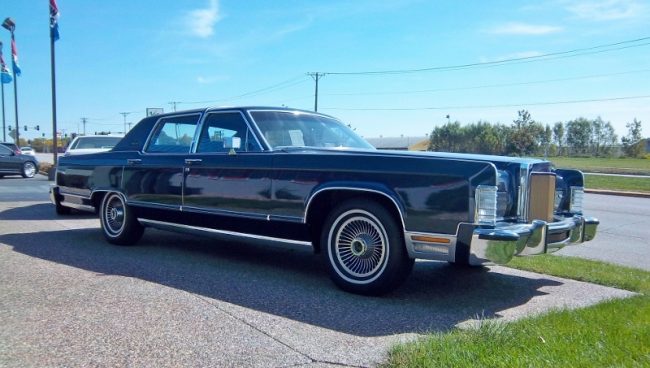
It was pampered and only driven by Bill and his wife to the Greek Orthodox church for services and the inevitable coffee/visiting sessions that came after. I got to sit in the driver’s seat of that car when I was about ten, and let me tell you, I was impressed. It was even bigger than the 1977 Continental Mark V my grandfather had, and that was saying something!
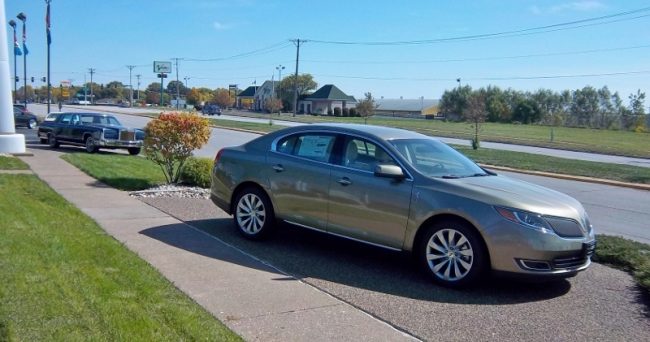
Sadly, Bill passed away in about 1998, and as we had moved across town in 1995, I never found out what happened to that car. Hopefully it went to one of his sons, or a good caretaker at any rate. It really was a family heirloom for them. Bill was always generous with his time, and I learned a lot from him–the first moped I ever saw was, you guessed it, in his garage. I remember his pointing out how it worked, what this was, and that did, etc. He talked to you as if you were an adult, not just a stupid kid, which, back then, I kind of was!
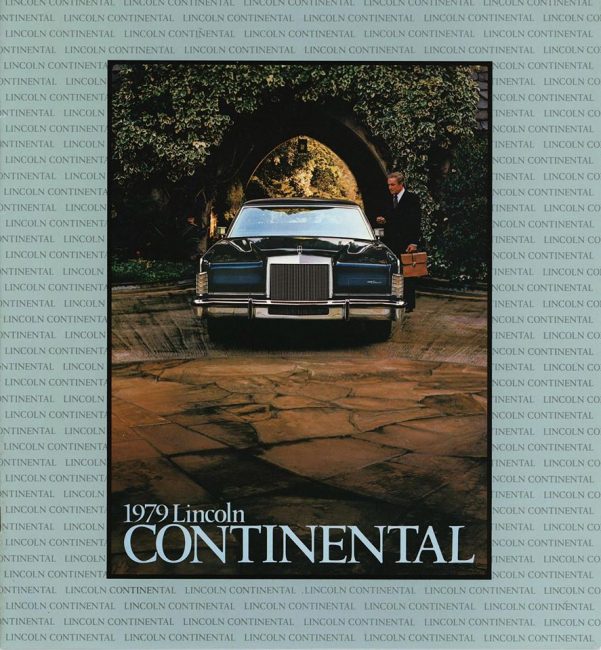
Today, the Collector’s Series is a minor collectible in four-door Continental form. The Mark V CS, needless to say, is much more popular these days (along with the Diamond Jubilee and Designer Series versions), but I must say, I’ve always loved the sedans. The Collector’s Series was the best of them all, when a Lincoln was REALLY a Lincoln.

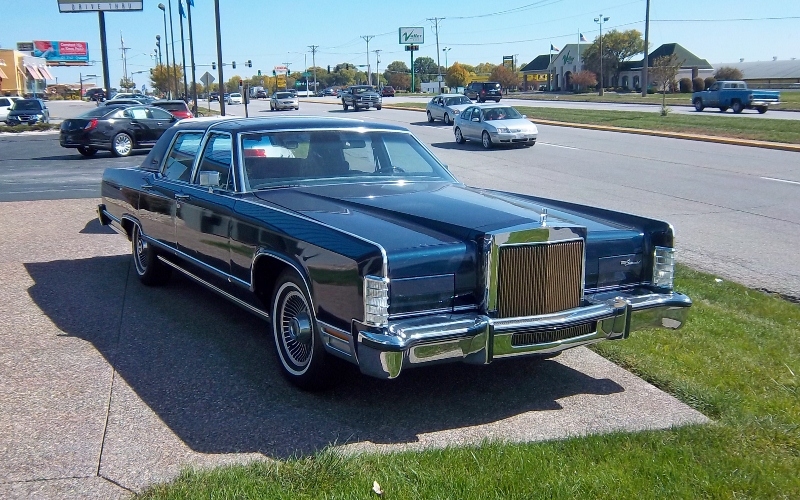






25 Comments
How did Lincoln go from making the 1961 Continental to trying to sell these rolling bordellos? The Mustang and the MKIII are why American cars are a joke to this day. They taught Detroit that engineering excellence was a waste of money. Before them, America made the best cars in the world. After them? Ford made this.
If only everyone could have just drove the 79 GLC. It was such a great little car, now with a Mizerly engine subbing for the ripped off German wanker er wankel. Nobody would ever think the yelling like Tarzan, dressing like Jane and smelling like Chetah people sending their 48 payments of their father’s money to Hirohito were jokes. What credibility, how authentic, what discerners of greatness.
In context, these were some of the greatest cars America ever created.
What context is that? One of the greatest in size?
When Lincoln and Cadillac made cars like these, they were still considered aspirational and brought some of the highest transaction prices in the market.
20 years later when these marques ceded to aping the euro cars, their models could only pull 2nd or 3rd tier status being sold at a discount to the elderly.
This car probably sat on a lot for at least five months when it was new before selling at a huge discount. Slow turn cars were no joke when we had the Jimmy Carter Misery Index. Double digit interest rates and inflation meant that dealers couldn’t wait for the right sucker. Once off the lot, it struggled to get out of its own way with 163 horsepower in a car that weighed two and a half tons. Lincoln was still selling their cubist Mark PLCs in 1979 where I lived, but these were about as relevant as new cars as Lincolns are today.
1979 is significant in Detroit history because it was the last year you could get a Cadillac with a good Cadillac engine. The 368s that followed were improbably slow followed by improbably awful at everything once they were fitted with cylinder deactivation. HTs were fragile and powerless. Northstars’ limp home mode was necessary without being luxurious. From 1977-1979, the 425 maintained the sort of performance delivered by the emissions-strangled 500 in the obese 1976s, but Lincoln keeping their gargantuan dinosaur of a sedan without a big engine was a mistake.
I agree that by ’79 the car was irrelevant. Just a few years earlier it was an aspirational standard. Things changed fast.
What happened? In succession, Robert McNamara happened, and then Lido Iacocca. Meantime the bean counters under Ed Lundy, and all overseen by an increasingly erratic Hank-The-Deuce.
In 1960, Lincoln was a semi-autonomous division. Ford, before McNamara, had taken steps to copy the GM structure – with Ford, Mercury, Lincoln and the new Edsel division all their own companies under the umbrella. Mercury had their own engines. Edsel was intended to have them, eventually…although depending on the model, it used Ford bodies and engines, or Mercury’s.
Lincoln was left to go its own way, and it created a trim, taut, unit-body car like no other, and so unlike the outrageous Cadillac of 1959.
McNamara went to kill Edsel, move Mercury back into the Ford structure, as a badge-engineered model sold through different dealers. Lincoln was left alone; but insofar as an understated Lincoln was concerned, Lido was no more a friend of the product than McNamara.
Lido was from a working-class urban Philadelphia family. He did not have blueblood roots, and didn’t understand their tastes. He liked bigger, longer, flashier, gaudier…and as President of the company, he saw to it that the 1970s Lincolns were HIS idea of a car for rich people.
And Henry II was more concerned about his own needs-of-the-flesh (two marriages imploding, and his sneaking around with a woman half his age) than he was of the car line. Probably he shared Lido’s tastes. In any event, the brands’ sharing of engineering, saved overhead – pushed by the army of Finance drones under Lundy.
Am I really the first to laud the term “rolling bordello?”
“rolling bordello” was originally a derisive term but now many have realized that they were wonderful in there unique way and will never return so it’s often used as a term of endearment now .
-Nate
I don’t care what anyone says, these are beautiful cars.
My grandfather had a burgundy ’79 when I was a kid and I loved that car. Such presence.
The 80s Town Cars were such a success later on in the 80s after people got over the Shah leaving Tehran. I wonder how one of these or the last really big New Yorkers had survived till say 83. Would the full size revival been even greater. Prices would have had to go up with consumer paid gas guzzler tax starting in 86. Fifth Avenue buyers had to pay, the only domestic. With an overdrive auto and fuel injection that tab might not have been so bad. Luxury cars that weren’t embarrassed to be American are so sorely missed.
Hey Tom, I checked Strieter Lincoln and the car must be sold already and you posted this today. Tom did you trade in the Town Car???
Ha ha, nope. I took these pictures almost seven years ago, in September ’12. The car has long been sold.
One trip to the buffet to many, still luxurious, soft and fancy, but these are the least interesting of this series, after they lost the unique Lincoln only dash with real gauges and 460 they were just marking time with fancy LTD dash with more bric-a-brac and the wheezetastic 165hp 400cid engine, the power vent windows were kind neat.
I don’t see how anyone except for a die hard Ford loyalist or a someone who thought any car that weighs less than 5000lb is just communism would choose one of these over the comparable Cadillac of the same era, i just don’t see any area where this car would have any kind of advantage.
I never minded the gilded Marquis/LTD dash, though I freely admit the 70-77 instrument panel was far superior. But it would have been nice if the 460 had lasted one more model year.
I might have been to harsh, but the dash does cheapen them out a bunch, I’d take one if you gave it to me or if it was super cheap, but they don’t appeal to me like a 1971-1976 Fleetwood would.
This is a fun to read and nicely written post with great photos. The beauty of collecting anything is: you can have more than one item! And, since it’s a hobby that lasts over time, you add to it gradually. I bought a used blue/leather CS sedan, as ever since seeing that 2-page Lincoln brochure photo I knew I had to own one someday. A unit came on the market that checked most of the boxes of my requirements, the price met my disposable income, and it was located in my part of the country. (NOTE: I, too, lament my ’79 is not equipped with the earlier Lincoln-spec dash. My cost-no-object fantasy is to commission grafting a dash from a ’77 donor into my ’79). I also admire the ’74-’76 Fleetwoods, and hope to eventually own one as well. However, decent Fleetwoods seem rarer that decent CS sedans, and usually are priced higher. So, for this enthusiast/collector, it’s not so much a matter of either/or, or being a die-hard Ford fan. I love the last of the largest US luxury cars, and can appreciate the both of the corresponding offerings from Cadillac AND Lincoln. This Lincoln joined my collection before a Fleetwood because I could afford it at the time, and it was available for sale ! The corresponding Fleetwood just hasn’t come along yet.
Neither of these are expensive or hard to find cars, they’re kind of a bargain at least as far as collector cars go, they’re an acquired taste, even to people that are into old cars. if there is a premium for the Fleetwood, well, theres probably a reason for it.
Carmine: IMHO, “expensive” & “hard to find” are relative terms. As for price, I paid $3500 for a 60k-miles 1-owner blue ’79 CS Sedan w/ leather & a moon roof advertised on Craigslist circa 2008. It was a fair price – Lincoln churned out a few thousand of these CS Sedans so they were really not all that rare, and of course a good number were put away “on blocks” which are appearing for sale now with virtually no miles on them. But, those “new” units usually trade hands for little more than the original sticker price. Mine’s not a museum piece, but never trashed or repainted. It needed a battery, tires, new rear main oil seal, brakes, shocks and stone chip paint touch up. However, it was the vehicle chosen to be photographed for the cover of the 2009 LCOC International Directory, so it was very presentable with only do-it-yourself detailing. In my experience, a comparable ’74-’76 Fleetwood Brougham (’76 in particular my favs) in a comparably limousine-like dramatic color combination (white, or black, or navy blue) would be priced higher…around $15,000 (especially a Talisman). Cracked dashes, cracked door panels, cracked steering wheels, cracked plastic bumper fillers, shrinking vinyl tops, sagging auto level controls, sagging door fitment and body rust around the vinyl tops & body trim are common – even on otherwise low mile well cared-for units. Badges are frequently mislocated or missing altogether after repaints. Restored interior door panels have often been done poorly. The auto climate control electrical components are trouble-prone, and the original buttoned/wrinkled leather – while handsome – is usually fairly hard 40+ years later, in contrast to the soft Lincoln leather which seems to have remained more supple. It’s hard to find a Fleetwood with all these items sorted out, and if you do, the asking price is usually very hefty. Comparable decent CS Sedans don’t routinely reflect the same expensive-to-repair ravages of time, but are often advertised for less money. In the final analysis, I believe more of the CS Sedans were preserved with reasonable care just by virtue of the “Collector Series” badge, than were ’74-’76 Fleetwood Broughams. Hence, more CS Sedans advertised for sale/auction than ’74-’76 Fleetwoods. That exerts downward pressure on the price of CS Sedans. The difference in purchase price between $5k & $15k is significant for this collector, particularly given the cost/availability of proper storage which vehicles built to this scale represent.
Your mileage may vary and I’ll leave it at that.
This is special! The Mk V Collectors was a bit more complex, the dashboard instrument bezels, “wood” trim, bucket seat pattern, console and door trim were specific to the CS. This doesn’t take anything away from the TC CS, it’s a site to see…peak brougham!
I owned many Lincolns, my favorite is my current 1978 Town Car, triple black, with the cloth pillow interior, factory CB and fantastic driving and riding car. I bought it from the original owner August 16th 2017, Guido spent it’s life in the garage. I also own another 1978 entry level Ford car, the Ford Pinto with 33,000 original miles from an 81 year old lady, who loved the Pinto, she just couldn’t drive anymore. Both my 1978 Lincoln Town Car and my 1978 Pinto are true Nevada rust free cars.
The Town Car still has R12 freon in the A/C and is freezing cold in the 115 Las Vegas heat….
Thanks for the great pix as always. The inlay on that steering wheel is handsome and I admired the detailed pattern on the shiny trunk trim. My German exchange brother in 1986 found these cars fascinating. He became a manufacturing engineer for Daimler. I don’t know how a car could look this good in Illinois unless it hibernated in winter. My uncle in Chicago missed one year of underbody treatment on his Volvo P1800 and that forlorn Rusty Jones sticker was a sad reminder of the ferocious power of road salt by the early 80s.
Tom ;
1st and foremost : you were _NOT_”stupid” ~ you were _ignorant as all children are and you ahead of most, understood the love of automobiles .
Anyway, I hope Bill gave you some rides in his car ~ they were smooth as glass and quiet like bank vaults .
-Nate